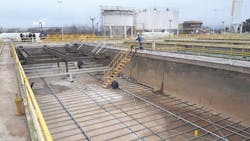One of Argentina’s most important water treatment plants has completed a transformation of its 14 sedimentation tanks, increasing its capacity, improving reliability, and reducing its environmental footprint.
Constructed in 1950, the Donato Gerardi treatment plant provides drinking water to 800,000 people in the province of Buenos Aires, Argentina. As the facility approached its 70th birthday, however, its age was beginning to show. Performance had declined over the decades, and operator Aguas de Buenos Aires SA (ABSA) knew that major upgrades were required.
In 2017, the state-owned utility contracted multinational water and energy specialist Veolia to undertake a comprehensive refurbishment of the facility. The aims of the project were to increase capacity, introduce new technologies, and deliver a plant that was ready to meet the demands of the 21st century.
One key part of the upgrade program focused on the facility’s 14 large concrete sedimentation tanks. The Donato Gerardi plant draws its water from the nearby Rio de La Plata, and the raw water contains high, and variable, quantities of suspended solids. In the rainy season, when turbidity levels often rise to 500 NTU , these tanks would rapidly accumulate large volumes of sludge that could only be removed manually with hoses, which meant it was common for the sedimentation system to be overwhelmed.
ABSA and the contractor wanted to fix the problem with the installation of a modern, automated sludge removal system. After a competitive tendering process, they selected the Zickert sludge scraper from Nordic Water, a Sulzer brand.
The Scraper System
The Zickert bottom sludge scraper uses a reciprocating framework of hydrodynamically shaped profiles mounted on the base of a sedimentation tank. When they move in one direction, these profiles catch the layer of highly concentrated sludge at the very bottom of the tank and move it toward a disposal outlet. In the other direction, the shape of the profiles allows them pass through the sludge with little disturbance.
This method of operation allows the scraper to remove waste with a very high concentration of solids, which means less waste for the operator to handle and higher overall process efficiency.
ABSA was confident of the performance of the system, since it already used the technology at several other plants across Argentina, and had even run comparative evaluations of different scraper systems at one of its sites. The results found that the Nordic Water scraper technology gave the best solution in terms of solids removal and sludge concentration. There was only one catch: the tanks at Donato Gerardi had been built with a V-shaped base profile that wasn’t designed to accommodate a bottom-mounted scraper system.
Setting a Baseline
To resolve the compatibility problem, Nordic Water and Veolia came up with a solution: They used lightweight concrete to fill the bottom profile of each tank, creating a flat surface ready for the new scrapers. To maintain plant operation during the upgrade, this process was completed one tank at a time, allowing the other 13 units to keep working.
In all, a total of 28 scrapers were supplied to the project, with two installed in each of the plant’s 42 meter by 11 meter tanks. They have performed effectively since their installation, removing an average of 400 m3 of sludge per hour from the raw water and ensuring that turbidity never exceeds 3 NTU at the decanters.
Automating sludge removal has eliminated the labor-intensive job of manual tank cleaning, and the sludge generated by the system contains more than twice the concentration of solids than before, reducing reduces the labor and energy required to transport the material for safe disposal. As part of the changes across the site, the new system has almost doubled the capacity of the plant, from 8,000 to 15,000 m3 of clean water per hour.



